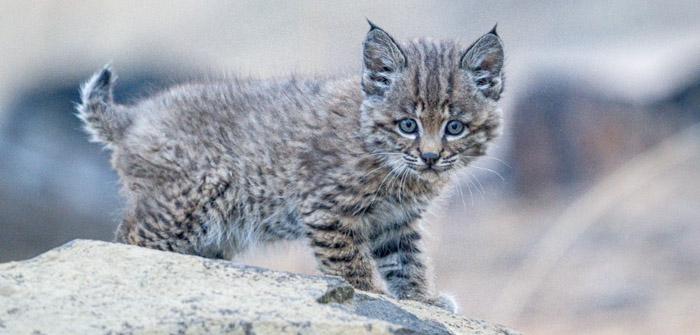(Approximately one month old | Photo courtesy of High Desert Museum)
A male bobcat kitten, approximately eight months old, is now in the care of the High Desert Museum. The public will begin to get to see the yet-to-be-named kitten periodically in the Museum atrium across from the permanent Spirit of the West exhibition.
The bobcat arrived at the Museum in October weighing less than three pounds. Individuals near Portland, Oregon removed the kitten from the wild and reached out to Oregon Department of Fish and Wildlife (ODFW). Biologists with ODFW informed them that animals will often leave their young for a period of time to feed, only to return later. The officials placed the bobcat back where he was found in the hope that his mother would return. The kitten was brought back into ODFW six days later by another individual, prompting ODFW officials to consider other options.
It is unknown whether the bobcat was truly orphaned or was simply separated from its parents by a well-meaning citizen. In either case, the kitten could not be returned safely to the original location, and rehabilitation of bobcats is not generally allowed in Oregon to avoid releasing human-habituated predators on the landscape. Seeking other options, ODFW then placed him at the High Desert Museum.
The bobcat currently weighs 15 1/2 pounds and is thriving in his new environment. The wildlife team at the High Desert Museum has expertise in caring for feline predators, and staff are training him to voluntarily crate and to participate in husbandry and vet care.
It will take about another year for the bobcat to reach a full size of 20-25 pounds. Wild bobcats eat a wide range of prey including birds and small mammals. The Museum wildlife team does its best to mimic a wild diet for the animals in its care, and the bobcat enjoys meals that include rats, mice, rabbit, quail and other whole-animal foods. He has done well so far and is a smart animal who has taken quickly to training and working with wildlife staff.
“The best thing to do when discovering baby or injured wildlife is leave the animal there and contact the local ODFW office to report it,” said Museum Curator of Wildlife Jon Nelson. “The best outcome is always to locate the mother so the animal can be raised and live in the wild, but ODFW is well-equipped to determine if the animal is legitimately abandoned or otherwise requires long-term human care.”
Bobcats are very common in the High Desert and are remarkable hunters. They are solitary animals that can thrive near humans and can be seen at times in suburban habitats. We encourage people to learn about, appreciate and coexist with our native wildlife.
“Caring for young wildlife is work that requires total dedication, and once again our wildlife team has risen to the challenge to give the bobcat the best possible home,” said Museum Executive Director Dana Whitelaw, Ph.D. “Although not generally a danger to humans, bobcats are also not housecats. Our team is working with him daily to ensure he will thrive here.”
For the coming weeks, the bobcat will periodically be visible in the atrium where Gert the gray fox presently resides. They cannot be in the atrium at the same time, so they will rotate and visitors will have the opportunity to view and learn about a gray fox or a bobcat, both with important stories and lessons we can take home to help conserve their habitats.
The opportunity to name the new bobcat will be auctioned off on Saturday, August 26 at the High Desert Rendezvous, the Museum’s largest fundraising event of the year.
The Museum cares for more than 130 animals, from otters to raptors. All the animals are nonreleasable, either due to injuries or because they became too familiar with humans. At the Museum, they serve as ambassadors that educate visitors about the conservation of High Desert species and landscapes.

